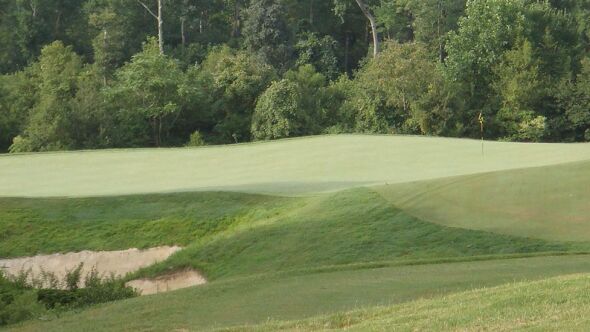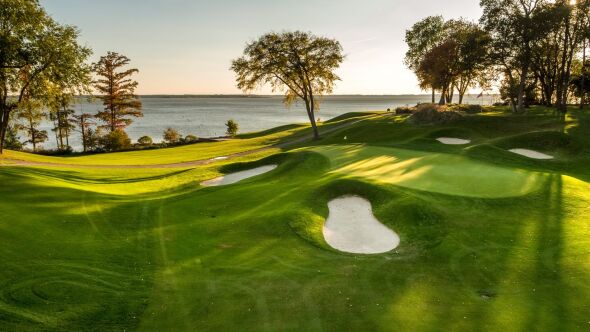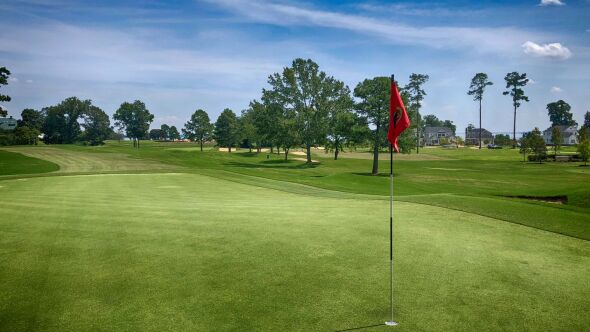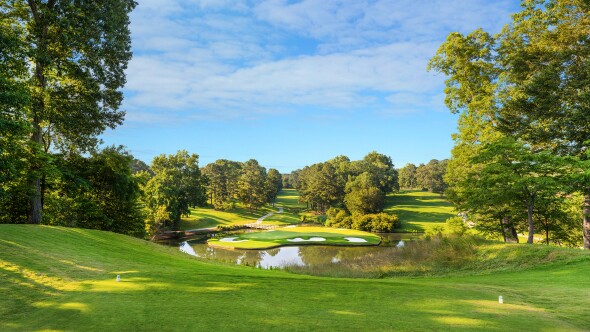WILLIAMSBURG, Va. - What could an 18th-century tavern and a late-20th century golf course possibly have in common?
More than you'd think.
After all, historic preservation is kind of a big deal around Williamsburg. The meticulously restored reminders of 17th- and 18th-century American life that sit at the heart of Colonial Williamsburg attract visitors with an appreciation for the past, and a desire to learn from it.
Stonehouse Golf Club in Toano and Royal New Kent Golf Club in Providence Forge both opened in 1996 nearby and have come to serve a similar function, not so much for U.S. History buffs but us history of golf nerds.
Just as the Colonial Williamsburg Foundation refurbishes centuries-old buildings in order to use them as a platform to enrich people's study of history, Stonehouse and Royal New Kent's caretakers are working hard to restore them to their prior shine. Now that they're coming back online, joined by two acclaimed resorts and a host of other public plays, they help buoy Virginia's Tidewater region as an enjoyable golf destination.
Golf in Williamsburg
Stonehouse and Royal New Kent's architect, Mike Strantz, was a man for his time in his chosen field. Working in the most fruitful era in the industry's history, when hundreds of golf courses opened in a given year, he managed to stand out from his peers with audacious, boundary-pushing designs that gained a cult following, as well as plenty of haters. You will scarcely find a practitioner of the craft whose work is more polarizing.
That sense of love or hate is likely to be solidified from the first tee shot at Royal New Kent ($98). The opening hole's fairway drops down and climbs back up, snaking between huge mounds covered in lost-ball rough. It's a blind shot from most tees, something likely to rankle meat-and-potatoes golfers. As is the case at the Pinehurst area's Tobacco Road Golf Club, Strantz' most famous course, golfers need to take it on faith that there's room to get going, especially considering the epic uphill approach to an enormous two-tiered green that awaits.
Royal New Kent's front nine is the golf equivalent of a fearsome rollercoaster. Blind shots, wild contours and one-off holes come at you so quickly as to be almost overwhelming, but if you play the right tees, you'll find it's more playable than it might initially appear. The golf course changes somewhat on the back nine, with the set-piece par-3 12th hole encircled by a residential neighborhood. The other one-shotter, the 15th, requires another heroic shot to a gigantic table-top green, and the long par-4 18th's peninsula green is surrounded by water on three sides, sitting in a chasm below the clubhouse. You don't agree to ride The Incredible Hulk expecting a gentle experience, and you don't tee it up at Royal New Kent expecting main-menu golf.
At Stonehouse ($98), Strantz applied a similar design vocabulary to a more wooded but near-mountainous site. Like Royal New Kent, Stonehouse is completely unwalkable, but it also might have the most exciting cart paths in public golf, so much so that drivers need to ride the brakes on steep, winding downhill stretches. Naturally, there are plenty of up-and-down holes and individual shots, with the par 3s being the heart of the routing. The long one-shot 3rd hole bursts out of a chute of trees to an amphitheater green and both the par-3 15th and 17th require tee shots over ravines to enormous putting surfaces. As at Royal New Kent, the interplay between visual intimidation and actual spaciousness makes a round a great deal of fun.
Both courses hit the hardest of times toward the end of the last decade, ultimately closing and starting to grow over. Cooling enthusiasm for golf between the late-Oughts Recession and the COVID-19 pandemic were especially hard on them, as Strantz's bold shaping and huge canvas taxed maintenance to the extreme. But each course was bought by a keen admirer of Strantz's work - local construction businessman Joe Sanders at Stonehouse; experienced course owner Barton Tuck at Royal New Kent - in order to preserve it for future generations of golfers. After years of benign and then outright neglect, both courses are well on their way back to being Mid-Atlantic must-plays for adventurous visitors.
Closer to the heart of Williamsburg, two resorts anchor the golf scene. Kingsmill Resort, which overlooks the miles-wide James River, is a great place to stay and play, especially for fans of championship golf courses, originally developed by Anheuser-Busch and sitting next door to the Busch Gardens amusement park.
Its River Course ($220), laid out by Pete Dye in 1974, hosted the PGA Tour from 1981 through 2002 and the LPGA Tour from 2003 through 2009 and 2012 through 2021. Like so many of Dye's excellent designs, the River does most of its damage when golfers get a little greedy. The brilliant par-5 3rd is fairly short and plays downhill, but its pedestal green is elusive. Most golfers will be within range after a good tee shot, but the pedestal green is much more suited to a wedge approach. Anything that misses left will tumble down a steep slope, leaving an awkward pitch. The River Course's inward nine brings it to the James during the closing trio, anchored by the tricky but beautiful par-3 17th. But I love the long two-shot 18th, where one of Dye's angled fairways poses a conundrum from every tee box: how much of the lake bordering the left side will you try to carry?
For its part, Kingsmill's Plantation Course ($140), a 1985 Arnold Palmer/Ed Seay effort, was a pleasant surprise. At just 6,400 yards from the tips, it's sporty, with narrow fairways and a healthy dose of doglegs. Its smallish but eccentrically contoured greens, each with multiple small compartments for hiding cheeky hole locations, keep things interesting. The par-5 second hole plays by the site of resort namesake Richard Kingsmill's 17th-century estate.
Note: In order to arrange golf at either the River or Plantation course, you will need to stay on property.
In the historic center of town, right across the street from Colonial Williamsburg proper, is Golden Horseshoe Golf Club, with 36 holes - Robert Trent Jones, Sr.'s Gold Course and son Rees' Green layout. The Gold ($199) is the must-play of the two, a quality mid-century parkland layout that hosted the 2007 NCAA Championship. The Gold draws considerable toughness from its par 3s, each of which has water in play, including the famous island-green 16th. But the best of the quartet is the 7th, which can stretch more than 200 yards, playing across a pond to a small green clinging to a ridge, with lost-ball potential to the right.
The Green Course's clubhouse is separate from that of the Gold, located a bit deeper into the woods. The layout ($99) is quintessential Rees Jones - large mounds line every fairway, there are 100-plus bunkers of varying sizes and the greens tend to feature little shelves and decks for Sunday pins. The par 5s feature the most variety; the 15th and 18th are fun three-shotters while the meaty 14th represents the best of the par 4s.
Lodging, dining and other Williamsburg golf trip notes
- Kingsmill Resort has a slew of member-owned three-bedroom villas, and the resort owns the handsome Cottages on the James, which are four-bedroom stand-alones perched on the riverbank and located within walking distance of the golf clubhouse.
- Colonial Williamsburg offers several lodging options; I stayed a couple of nights in the Williamsburg Lodge, an Autograph Collection hotel consisting of a cluster of guest houses. The Lodge is literally across the street from Golden Horseshoe; there's something very charming about strolling next door to play golf. Other Colonial Williamsburg hotels include the Williamsburg Inn and the Griffin.
- As is true of most centuries-old locales, Williamsburg is delightfully walkable. The Merchants Square downtown district is a great spot for shopping and dining; the inventive tacos from Electric Circus, which operates from inside the funky Precarious Beer Project brewery, are excellent.
- Part of the Colonial Williamsburg experience is a series of restaurants that aim to give diners a sense of what it was like to eat out in the 18th century, using recipes and service touches from that era like period servers garb and a musician who wanders the dining rooms singing sea shanties. Christiana Campbell's Tavern is a good time; the lobster in my "seafood pye" was very tasty.
- Kingsmill is home to a third golf course, The Woods, though it's the exclusive domain of members of The Club at Kingsmill and their guests. Architect Tom Clark designed it with consultation from two-time U.S. Open champ and native Virginian Curtis Strange. You won't be able to book rounds there without a connection, but buy the right person a drink and you could score an invite.
- At a time when many destinations are adding short-form golf, both of Williamsburg's main resorts have recently closed theirs. At Kingsmill, the former Bray Links par-3 course made way for an expanded pool complex, and at Golden Horseshoe, the 9-hole executive Spotswood course lies growing over, awaiting real estate development, although signs around the adjacent neighborhood state their vehement disapproval of the plan. Perhaps there's a mixed-use compromise that enables a new short course to use some of Spotswood's acreage; it would be a great addition to the area's golf.
- If you're flying in, Richmond (RIC) is the airport to target, at about 50 minutes from central Williamsburg. It's on the southeastern outskirts of the city, so it's really easy to get in and out of.
- Williamsburg is part of GolfPass' list of the World Top 100 Golf Destinations.

 Back
Back














































